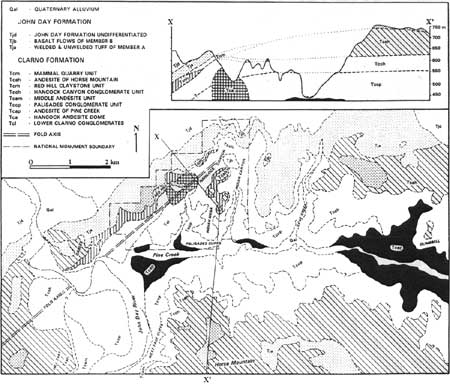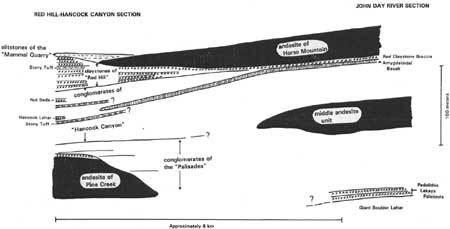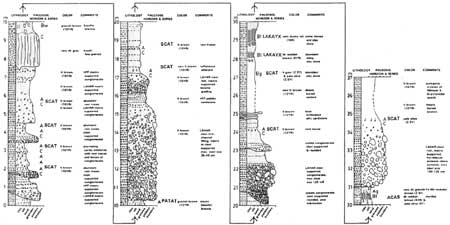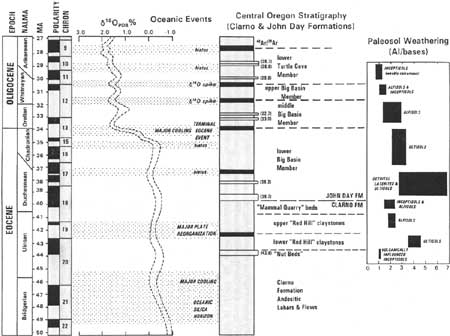|
JOHN DAY FOSSIL BEDS
Geology and Paleoenvironments of the Clarno Unit John Day Fossil Beds National Monument, Oregon |

|
CHAPTER II:
GEOLOGIC FRAMEWORK OF THE CLARNO AREA
INTRODUCTION
The alluvial strata, paleosols. tuffs and lava flow units studied in the Clarno Unit area are in the Clarno and lower John Day Formations, and span middle Eocene to middle Oligocene time. This chapter outlines geologic and paleoenvironmental findings of a three year study of the Clarno Unit and describes new informal lithostratigraphic subdivisions of the Clarno and John Day formations (Fig. 2.1). Data presented in this report were largely gathered from measuring and describing stratigraphic sections of outcrops, with extensive trenching to exposed fresh rock beneath badlands mantled with soil, and mapping of units using low elevation color aerial photographs (Fig. 2.2 and maps of Plates I and II).

|
| Figure 2.1. Composite stratigraphic section of the upper Clarno and lower John Day formations in the Clarno area. Age determinations obtained from C. Swisher as part of this project. |
The informal stratigraphic subdivisions of the Clarno Formation are based on rock type and stratigraphic position. The John Day Formation is also divided into informal units following both western facies stratigraphic nomenclature of Peck (1964) and Robinson (1975) and eastern facies nomenclature of Fisher and Rensberger (1972). This chapter investigates the geologic framework of these stratigraphic subdivisions and examines the tectonic and paleoclimatic implications of these paleosols and associated volcanic units during the waning stages of Clarno volcanism and initial stages of John Day volcanism.
A major discoveries in the Clarno Unit area is the approximately 4 million year time span between the "Nut Beds" fossil site and the "Mammal Quarry" fossil site. This span of time is occupied in large part by the red beds of "Red Hill" which record a long period of humid subtropical soil formation. The "Mammal Quarry" beds are associated with a widespread andesite flow unit (andesite of Horse Mountain) which is stratigraphically at the top of the Clarno Formation in this area. Another discovery includes the stratigraphic position of the "Nut Beds" in the upper part of the Clarno Formation in the same package of lahars as the "Hancock Tree." These conglomerates and tuffs onlap the Hancock dacite dome.
A second important discovery in the Clarno Unit is the placement of the Eocene-Oligocene boundary high up in the John Day Formation, stratigraphically just below the Bridge Creek flora site at the "Slanting Leaf Beds." An Eocene-Oligocene boundary age of approximately 34 Ma is accepted here based on single-crystal, laser fusion 40Ar/Ar39 dates and magnetostratigraphy of North American non-marine rocks (Swisher and Prothero, 1990; Prothero and Swisher, 1992) and the paleomagnetic record from the ocean ridges (Cande and Kent, 1992). New age determinations from tuffs in the lower John Day Formation include a date of 39.2 Ma from the basal welded tuff of member A and clearly indicates a late Eocene age (age determinations by C. Swisher; reported in Bestland and others, 1993).
Table 2.1. Informal locality names for the Clarno area
| NAME | DESCRIPTION | TOWNSHIP & RANGE |
| "Black Spur" | Basalt capped ridge below "Mammal Quarry" | SE1/4 sec. 27, T7S, R19E |
| "Equisetum Canyon" | Steep, small canyon cut into conglomerates of Palisades | NW1/4 sec. 35, T7S, R19E |
| "Dumbbell Butte" | Large, hoodoo-forming butte capped by andesite and shaped like a dumbbell | center sec. 32, T7S, R20E |
| "Hancock Canyon" | Main drainage in the Camp Hancock area | sec. 26, T7S, R19E |
| "Indian Canyon" | Lower part of north-south drainage that joins Pine Creek at the Palisades | E half sec. 26, T7S, R19E |
| "Indian Mesa" | Small plateau capped by conical knolls between Indian and Hancock canyons | NW1/4 sec. 35, T7S, R19E |
| "Italian Hill" | Red, yellow, and green banded hill of lower John Day Formation (hill 2802) | NW1/4 sec. 24, T7S, R19E |
| "Mammal Quarry" | Abandoned paleontology excavation in yellowish-brown siltstones | E half sec. 27, T7S, R19E |
| "Nut Beds" | Resistant buff cliff containing abundant silicified plant fossils | S half sec. 27, T7S, R19E |
| "Palisades" | Hoodoo-forming cliff at the junction of Pine Creek and Indian Canyon | center sec. 25, T7S, R19E |
| "Red Hill" | Red and white banded ridge northwest of Hancock Field Station | S half sec. 27, T7S, R19E |
| "Sienna Ridge" | Small badland area near the divide between Indian and Hancock Canyons | NE1/4 NW1/4 sec. 26, T7S, R19E |
| "Slanting Leaf Beds" | White fossil leaf bearing outcrop | SE1/4 sec. 22, T7S, R19E |
| "West Face Cliffs" | Large cliffs on the east side of the John Day River south of Clarno | Secs. 10 & 3, T8S, R19E |
| "Whitecap Knoll" | White capped knoll above red badlands in lower John Day Formation | NW1/4 sec. 26, T7S, R19E |
Stratigraphic nomenclature
In this report, new stratigraphic units identified are all informal in accordance with rules about such units in the North American Commission on Stratigraphic Nomenclature (1983). The new subdivisions of the John Day and Clarno formations will be denoted by lower case such as "lower Big Basin Member." Other options for naming these new units included, for example, "lower Big Basin beds" or "lower Big Basin sequence." All three of these names are informal units, are not capitalized, and therefore do not need to conform to the formal requirements of the code. Some of the new divisions conform to the concept of "beds," however, formal members would be needed in order to refer to these units as beds. Beds as explained by Article 26a of the Stratigraphic Code, "should be limited to certain distinctive beds ...". Examples of lithostratigraphic units in the Clarno Unit area that follow the concept of beds would be the "Nut Beds" or "Mammal Quarry" beds. Formal declaration of units such as the conglomerates of Hancock Canyon as a member of the Clarno Formation is beyond the scope of this project. Many of the stratigraphic sections and localities in this report are referred to with informal place names (Table 2.1).
Radiometric age determinations
Three new radiometric age determinations were made by C. Swisher of the Institute of Human Origins using single crystal, Ar40/Ar39, laser fusion methods (Table 2.2). This method involves the age determination of multiple grains of feldspar from tuff samples (Appendix 7). In samples with fresh feldspar crystals that were produced during the same volcanic event, the ratio of Ar40 to Ar39 will be much the same in each crystal and yield similar age estimates. If the crystals were weathered or altered during or since burial, Ar gas may have escaped from the crystal causing the determined age to be anomalously young. Feldspar grains incorporated from older deposits but still fresh will yield older ages compared to the majority of grains from the primary volcanic source. With this single crystal method, altered grains and older detrital grains can be identified and separated from a population of fresh grains of uniform age and so can be discarded from the age estimate. Previous "whole rock" or "feldspar separate" age determination techniques did not have this kind of single-crystal control. Thus, the new age determinations presented here and elsewhere using this method are generally significantly older and more precise than previous age determinations of the same units probably because of the incorporation of altered grains in the previous age determinations.
Table 2.2. New Ar40/Ar39 age determinations from the Clarno Unit
| unit | mineral type | number of crystals | Age | standard deviation | rounded age |
| Member A | Sanidine | 7 | 39.22 | 0.027 | 39.2 ± 0.03 |
| White Knoll tuff | Plagioclase | 5 | 38.19 | 0.06 | 38.2 ± 0.06 |
| Slanting Leaf beds | Plagioclase | 6 | 33.62 | 0.19 | 33.6 ± 0.2 |
CLARNO FORMATION
LITHOSTRATIGRAPHIC UNITS
Lower Clarno Formation units
Conglomeratic debris flow deposits of uncertain affinity and of local extent were first recognized by Hanson (1973) in a structural dome just west of Hancock Field Station (Fig. 2.2). The partial dome in this area was interpreted by Hanson (1973) to be a structural window into lower Clarno Formation strata that had been deformed and onlapped by later Clarno Formation deposits. Mapping of the deposits during the coarse of this work indicates that a partial dome is present, however, the stratigraphic position and relationship of the deposits with the dacite body is not clear. The structural dome plunges away from the dacite dome (Plate II) but, a careful search of the deposits on the south side of the dacite dome failed to reveal a clear intrusive relationship. Our current interpretation is that there is a lower sequence of strata that was deformed by the emplacement of the dacite dome and that these deposits were onlapped by the main section of Clarno Formation units (Fig. 2.3).
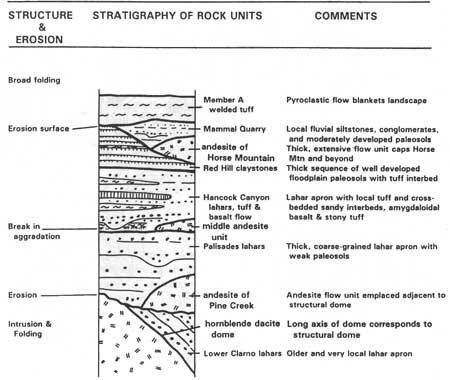
|
| Figure 2.3. Diagrammatic summary of the geologic history of the Clarno Formation in the Clarno area. |
Lower Clarno conglomerates. A sequence of boulder-sized, matrix-supported conglomerates exposed just to the west of Hancock Canyon is the oldest and most deformed unit in the map area and is referred to as lower Clarno conglomerates. This unit was recognized first by Hanson (1973). Clasts of boulders and cobbles of altered plagioclase porphyritic andesite are common in the debris flows. The unit lacks tuff beds or paleosols which could aid in stratigraphic correlation. The southwestern half of a structural dome is defined by the strike and dip of a resistant debris flow bed that is extensively exposed in this unit (Plate II). The andesite of Pine Creek apparently overlies these folded debris flows, however, a small and poorly exposed outcrop just west of the access road to Hancock Field Station (NE1/4 sec 34; P. Hammond pers. communication, 1992) is the only exposure of this contact. Another less likely stratigraphic interpretation is that this unit is part of the conglomerates of the Palisades which have been locally faulted and folded.
Hancock dacite dome. A plagioclase hornblende dacite porphyry is exposed in the hills and gullies to the northeast of Hancock Field Station (Figs. 2.2 and 2.3). Excellent exposures of this unit in tributary gullies of Hancock Canyon indicate that it is a homogenous igneous body and not boulders of dacite weathering out of a debris flow as has been interpreted previously (unpublished mapping by E.A. Bestland, D.L.S. Blackwell, and M.A. Kays). This igneous body was first recognized by Hanson (1973) and referred to as an andesitic intrusion. Geochemical analysis of this unit during the course of this project and with the help of P. Hammond, indicates that this unit is of dacitic composition (see geochemical section of this chapter). Stratigraphic sections of strata directly overlying this igneous body do not show intrusive features such as baking, veining, hydrothermal alteration and mineralization (Fig. 2.4a-d). The overlying claystones contain boulders exclusively of weathered, altered hornblende dacite (Fig. 2.4). The claystones are interpreted as well-developed paleosols of the Pswa pedotypes that developed on an igneous body and which incorporated colluvial debris (dacite clasts) from the underlying dacite. Thus the dacite body was an erosional feature that was mantled by colluvium and soils. The lack of intrusive igneous features in onlapping conglomerates of the Palisades and Hancock Canyon and the presence of cobbles and boulders of the dacite in colluvium suggests that the dacite was a topographic feature, probably a stubby lava flow or a lava dome. The Hancock dacite dome is pervasively altered, probably by deep weathering during the Eocene.
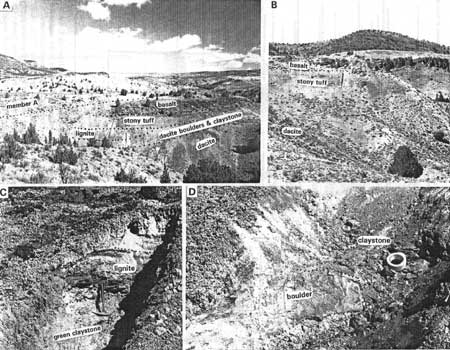
|
| Figure 2.4. Photographs of the Hancock dacite dome and overlying stratigraphic units. Figure. 2.4A. View of "Black Spur" and the dacit-basalt section. Figure 2.4B. View of "Black Spur" capped by basalt and underlain by dacite. Figure. 2.4C. Lignitic siltstones interbedded with green claystones (Cmuk pedotype). Figure. 2.4D. Boulder of weathered hornblende dacite surrounded by claystone (Pswa pedotyp). |
A dike of dacite can be observed to intrude lower Clarno conglomerates along the track to the "Nut Beds" from the field station. This observation constrains the age of the dome to between deposition of the lower conglomerates and conglomerates of the Palisades. Vance (1988) has dated a comparable dacite clast in lahars overlying the "Fern Quarry" by fission track at 44.3 Ma, older than dates of 43.6-43.0 on fossil localities of the conglomerates of Hancock Canyon.
Main section
In the Clarno Unit area, the Clarno Formation contains laterally extensive and mappable lithostratigraphic units (Fig. 2.5, Plates I and II). These units are of three types: 1) andesitic debris flow packages, 2) andesite lava flows, and 3) claystones. Smaller-scale lithostratigraphic units, such as basalt flows or thin andesite flows, tuff beds and minor red beds were used to characterize and help identify larger stratigraphic packages (Plate II). Of the three lithostratigraphic types, the debris and andesite flow units constitute the majority of the cliffs along the John Day River in the area south of Clarno bridge and along the western part of Pine Creek.
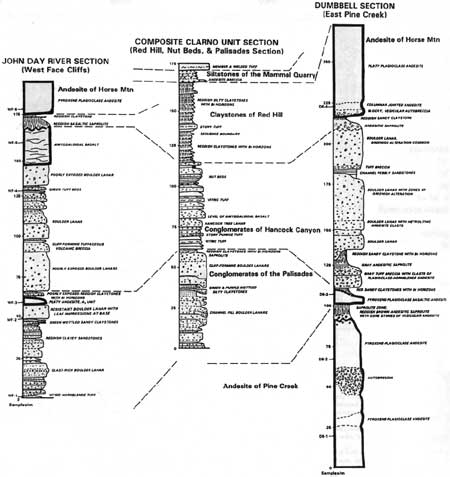
|
| Figure 2.5. Fence diagram of the Clarno Formation in the Clarno Unit area.(click on image for an enlargement in a new window) |
Andesite of Pine Creek. The base of the stratigraphically coherent section in the Clarno Unit area is a thick andesite referred to as the andesite of Pine Creek. This consists of thick lava flows of dark-colored pyroxene-plagioclase andesite that are altered by varying degrees. The andesite flows have a very irregular upper surface which is mantled by a well developed red saprolite breccia. To the east of Cove Creek, this basal andesite unit is extensively exposed and contains a number of different subunits. The lowest flows in this area are thick, autobrecciated andesite flows that contain abundant plagioclase phenocrysts and are present in the lower third of hill 2932 ("Dumbbell Butte"). Several dark-gray, basaltic andesite flows onlap the thick autobrecciated andesite on the west side of hill 2932. The stratigraphic relationship between the andesite in the lower part of Pine Creek with the andesite to the east of Cove Creek in not known.
Paleorelief of this unit is best exposed in cliffs along Pine Creek between the "Palisades Cliffs" and the entrance to Hancock Field Station where more than 40 vertical meters of andesite is onlapped by debris flows over a lateral distance of 200 m. Pockets of red and white claystones are preserved between the andesite and overlying debris flows and were mapped separately (Plate II). The claystones are best exposed in roadcuts just east of the Palisades wayside on Highway 218. The clayey saprolite and claystones erode to form an erosional bench which is occupied in part by the modern Pine Creek floodplain. Basal sapping of these cliffs is in part due to the erodability of these claystones.
Conglomerates of the Palisades. Onlapping the irregular surface of the andesite of Pine Creek is a thick sequence of debris flows dominated by clasts of andesitic composition. The conglomerates of the Palisades weather to form the spectacular hoodoos along Pine Creek and in the lower part of the "West Face Cliffs" along the John Day River (Fig. 2.7a-d, Fig. 2.8). Most of the conglomerates are matrix-supported, moderately clast-rich, laterally continuous and interpreted as floodplain debris-flows (in the sense of Scott, 1988). The "Palisade Cliffs" contain numerous clast-rich, channelized debris flows. Some are clast supported at their base. Hyperconcentrated flood flow deposits (in the sense of G.A. Smith 1986; and Nemec and Muszynski, 1982) are common at the base of debris flows where they grade into debris-flow deposits. Well exposed at approximately the middle of this unit are several thin, green, clayey paleosols with wood fragments and leaf impressions. These thin, green paleosols, of the Scat and Sitaxs pedotypes, are present in the Palisades section and are well exposed in the lower part of the cliffs along the John Day River. Above the green clayey horizons is a tuffaceous breccia layer which grades up into a massive debris flow. This debris flow weathers brown-orange and crops out prominently along the "West Face Cliffs."
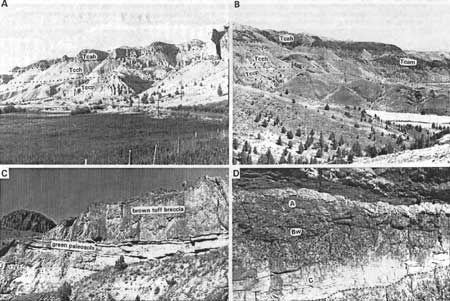
|
| Figure 2.7. Photographs of the "West Face Cliffs" along the John Day River showing the conglomerates of the "Palisades" (Tccp), conglomerates of Hancock Canyon (Tcch), middle andesite unit (Tcam), and andesite of Horse Mountain (Tcah). Figure 2.7A. The "West Face Cliffs" viewed from the south. Figure 2.7B. The "West Face Cliffs" viewed from the north. Figure 2.7C. Lahars and paleosols in the conglomerates of the "Palisades." Figure 2.7D. Close-up of Sitaxs paleosols with well developed green and purple mottles (from exposure shown in Figure 2.7C). |
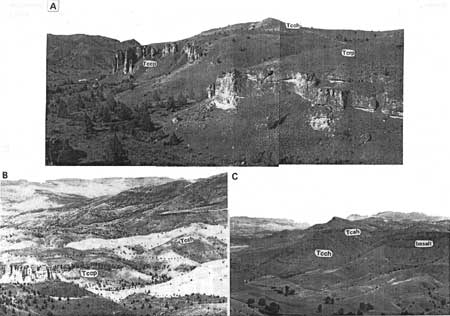
|
| Figure 2.8. Photographs of the conglomerates of the "Palisades" and the conglomerats of Hancock Canyon. Figure 2.8A. The "Palisade Cliffs" in Indian Canyon. The bench above the cliffs is caused by poorly resistant red claystones between the two conglomerate units. Figure 2.8B. The "Palisade Cliffs" and "Indian Mesa" viewed from the top of Horse Mountain. Figure 2.8C. The southwestern flank of Horse Mountain. |
To the east of Cove Creek, conglomerates of the Palisades onlap, thin and pinch-out against andesite of Pine Creek (Figures 2.2). From the "Palisades Cliffs" to exposures in canyons on the north side of Horse Mountain this lahar package has a dip of approximately 2° toward the northwest and away from former volcanic highlands to the southeast. This dip is interpreted as an original debris flow apron gradient and indicates a source area to the southeast.
Saprolite mantles the conglomerate of the "Palisades" and is commonly overlain by brown and red claystones (paleosols). These claystones erode to form a bench on the mesa between Hancock Canyon and Indian Canyon (Indian Mesa on Fig. 2.2). This bench is also present on the north and west sides of Horse Mountain and along the canyon walls of Cove Creek. These fine-grained deposits and claystones weather to form low angle slopes and reddish soil and were mapped separately (unit Tcrp on Plate II). They are well exposed in the south spurs of the first upstream westward branching gully of both Indian Canyon and Cove Creek. A continuous stratigraphic section is exposed in the southern part of Cove Creek and contains in stratigraphic order conglomerates of the "Palisades," several red claystone horizons, conglomerates of Hancock Canyon, several red claystone horizons of the claystones of "Red Hill," and welded tuff of basal John Day Formation member A. These claystone interbeds can be traced to the east and documents the pinch-out of the conglomerates of the "Palisades" against the andesite of Pine Creek.
Middle Clarno andesite. This thick andesite is locally present in the southern part of the project area south of Clarno along the John Day River. Along the John Day River the unit makes-up the lower half of the monolithic buttes on the west side of the river (hills 2441 and 2373, sec 9). Here it is a blocky, dark colored, pyroxene-plagioclase andesite. In the very most southern part of the project area (center of sec 9), the andesite fills a paleovalley cut into the conglomerates of the "Palisades." This andesite, or its stratigraphic equivalent, crops out extensively in the upper reaches of Hay Bottom Canyon and canyons to the north. Thick accumulations of flow breccia, autobrecciated flows and associated andesite flows are interbedded with debris flows of the conglomerates of "Hancock Canyon." A stratigraphic interpretation possible from these relationships is that the lava flow capping "Dumbbell Butte" may be part of this lava flow sequence and not part of the andesite of Horse Mountain. Along the John Day River, the unit is clearly onlapped by conglomerates of Hancock Canyon.
Conglomerates of Hancock Canyon. Overlying the red claystone interbed at the top of the conglomerates of the "Palisades" is the conglomerates of Hancock Canyon (Fig. 2.8). Like the conglomerates of the Palisades, clasts are principally of andesitic composition. A nearby volcanic source is also indicated by heavy minerals of the "Nut Beds" which are mainly of volcanic affinities (77% magnetite/ilmenite, 12% altered volcanic, 2% zircon, 4% pyroxene and 2% rutile) with less than 2% possible metamorphic minerals (garnet, epidote, amphibole; M. Sorenson, pers. comm., 1983). This unit includes tuffaceous beds and a distinctive basalt flow, but is dominated by matrix-supported boulder debris flows (Figures 2.9 and 2.10). Deposits of this unit onlap the Hancock dacite dome and the middle andesite unit. The prominent bench and red soil produced by an interbed of red claystone separates conglomerates of the "Palisades" from conglomerates of Hancock Canyon. In the Clarno Unit area, the conglomerates of Hancock Canyon can be distinguished by their more prominent bedding, less coarse-grained and massive texture, and common thin tuff interbeds when compared with the conglomerates of the "Palisades." Toward the east from the Clarno Unit area, conglomerates of Hancock Canyon are dominated by thick, coarse debris flows and contains few fine-grained tuffs or medium-grained lahar-runout type deposits so common in Hancock Canyon (Fig. 2.10b). A distinctive and widespread amygdaloidal basalt flow occurs stratigraphically in the upper half of the unit (Fig. 2.11). The basalt is holocrystalline, contains common plagioclase and pyroxene grains and displays pahoehoe flow structures and local columnar jointing. The basalt can be mapped from the Hancock Field Station area to the Gables, is thickest in the "West Face Cliffs," but is not present east of Indian Canyon (Plate I and II). This basalt flow can be traced along the cliffs of the John Day River south to Melendy Ridge.
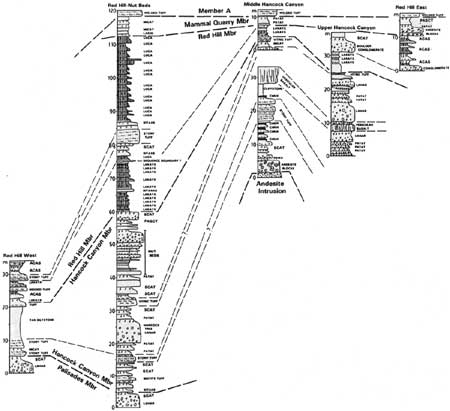
|
| Figure 2.9. Fence diagram of the conglomerates of Hancock Canyon and claystones of "Red Hill" in the "Red Hill"-Hancock Canyon area. (click on image for an enlargement in a new window) |
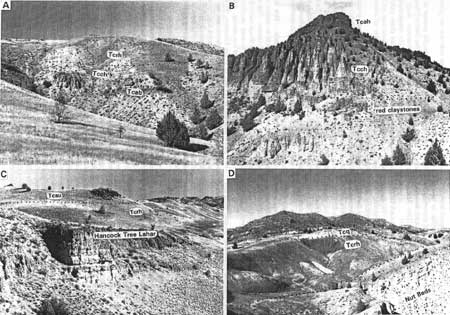
|
| Figure 2.10. Photographs of conglomerates of Hancock Canyon. Figure 2.10A. The amygdaloidal basalt pinches-out between debris flows in the canyon of the "Hancock Tree". Figure 2.10B. The upper part of the "Dumbbell Butte" section with red claystone horizons underlying conglomerates of Hancock Canyon. Figure 2.10C. View looking east of the debris flow that contains the "Hancock Tree" with the upper andesite of Horse Mountain (Tcau) and claystones of "Red Hill," in the background. Figure 2.10D. "Red Hill," underlying "Nut Beds" unit of the conglomerate of Hancock Canyon, and overlying siltstones of "Mammal Quarry" exposed in trench at the top of the hill. |
The conglomerates of Hancock Canyon contain the "Nut Beds" fossil site (Fig. 2.10a) and the Muddy Ranch tuff, both dated at approximately 44 Ma; Carl Swisher obtained a date of 44 Ma from a plagioclase separate from a reworked crystal tuff in the "Nut Beds" using the 40Ar/39Ar method (pers. comm., 1992), and Brent Turin (for Manchester 1990, 1994) used the same method on plagioclase of the "Nut Beds" for an age of 43.766±0.29 Ma, and Joe Vance (1988) obtained a date of 43.6 and 43.7 Ma from fission track of zircon crystals in the 'Nut Beds" and 44 Ma in the Muddy Ranch Tuff (also known as the Rajneesh Tuff) near the Gables. The Muddy Ranch tuff is stratigraphically below the "Nut Beds." Many large, well-preserved Cercidiphyllum (katsura) and Macginitea (sycamore) permineralized tree trunks and limbs are in this unit, similar to the "fossil forests" found in comparably-aged Lamar River Formation on the Yellowstone plateau (Dorf, 1964; Retallack, 1981b).
Another prominent, although local unit is a tuff breccia debris flow deposit that contains abundant purplish-gray hornblende andesite clasts. This unit was mapped separately in the Indian Mesa area, and referred to as the lavender lahar. The unit grades into an autobrecciated andesite flow which is exposed at the base of the debris flow unit on the west spur of hill 2066 (SW 1/4 sec 26 on "Indian Mesa," Plate I). The boulders and cobbles of hornblende andesite have a light gray-purple weathering rind and forms fields of light colored boulders where they weather out from the debris flow matrix.
Claystones of "Red Hill." In the Clarno Unit area, a thick sequence of reddish (Lakayx pedotype) and grayish-purple (Acas pedotype) claystones overlie the conglomerates of Hancock Canyon (Fig. 2.10d and Fig. 2.12). The unit is 59 meters thick in the "Red Hill" area (Fig. 2.1) but thins dramatically to the east (Fig. 2.2 and Fig. 2.13). In the cliffs on the west and north side of Horse Mountain, only a reddish saprolite with thin clay layer is present at this stratigraphic level. The unit at "Red Hill" contains a lower reddish paleosol sequence of very deeply weathered Ultisol-like paleosols (Lakayx pedotype) and an upper less well developed, Alfisol-like paleosol sequence (Luca pedotype; G.S. Smith, 1988; Retallack, 1991a). A stony tuff bed above the lowest Luca paleosol approximately divides the two paleosol sequences. Detailed descriptions of these paleosols are given in Chapter III.
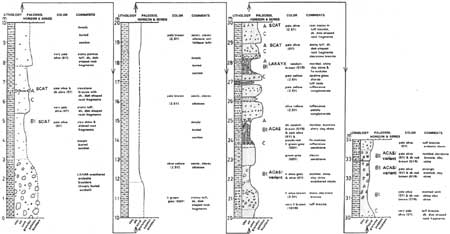
|
| Figure 2.12. Stratigraphic section of "Red Hill" West. (click on image for an enlargement in a new window) |
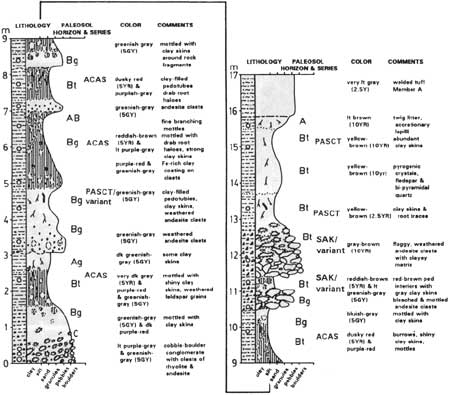
|
| Figure 2.13. Stratigraphic section of "Sienna Ridge" (also called "Red Hill" east). (click on image for an enlargement in a new window) |
Conglomeratic beds are locally present in the claystones. At the southern tip of the Gables (Plate I), a thick, coarse-grained conglomerate body is interbedded with red claystones. The conglomerates are clast-supported, contain rounded clasts andesite and amygdaloidal basalt. The conglomerates cut into underlying units of the conglomerates of Hancock Canyon (Fig. 2.14c).
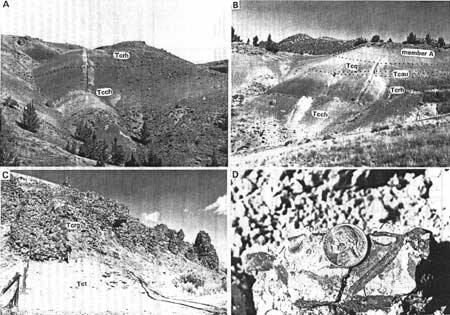
|
| Figure 2.14. Photographs of "Red Hill" east and west localities. Figure 2.14A. "Red Hill" west showing contact between the conglomerates of Hancock Canyon (Tcch) and claystones of "Red Hill" (Tcrh). Figure 2.14B. "Red Hill" east section with saprolitic conglomerate at the top of conglomerates of Hancock Canyon (Tcch), a truncated section of claystones of "Red Hill," a saprolitic andesite breccia (Tcau), siltstones of the "Mammal Quarry" (Tcq), and member A of the basal John Day Formation. Figure 2.14C. Fluvial conglomerate unit of the claystones of "Red Hill" exposed at the Gables cutting into welded tuff unit of the conglomerates of Hancock Canyon. Figure 2.14D. Plant remains and accretionary lapilli from the base of the member A tuff. |
The claystones of "Red Hill" are prone to landslides. Most landslides mapped on Plate I and II occur where thick exposures of these claystones are overlain by the welded tuff of member A of the basal John Day Formation. Good examples of these landslides occur on the eastern side of "Indian Canyon." The landslides do not appear deep seated; the coherent blocks of member A form shallow, rocky slides, which in some cases are similar in appearance to rock glaciers.
Andesite of Horse Mountain. This thick andesite unit is extensively exposed in the project area where it caps much of Horse Mountain. The unit consists of platy to blocky andesite which varies from pyroxene-plagioclase andesite to very porphyritic plagioclase dacite with traces of hornblende. Along the west and north side of Horse Mountain, the unit overlies a thick red saprolite developed on the amygdaloidal basalt flow in the Hancock Canyon unit. Ramp-like flow structures are common in lava flows exposed in the "West Face Cliffs." The base of the unit dips gently to the west, probably following a paleoslope.
An upper andesite unit is recognized based on stratigraphic position and lithology. On the rolling top of the west part of Horse Mountain, a plagioclase phyric, basaltic andesite flow is exposed above thin red claystones (paleosols) and below member A of the basal John Day Formation. This unit (Tcau) was mapped separately on Plate I and identified by bulk rock geochemistry (see geochemistry section). Lithologically and geochemically similar andesite crops out in the upper part of Hancock Canyon where it forms the base of the siltstones of the "Mammal Quarry" in the "Red Hill" east section (Figures. 2.13 and 2.14b). A saprolite andesite breccia can be traced into coherent exposure of the upper andesite unit.
Siltstones of the "Mammal Quarry." The tan, clayey siltstones and cobble conglomerates of the "Mammal Quarry" beds are only locally present in the "Red Hill"-Indian Canyon area. Vertebrate remains in this unit make it paleontologically important. A diverse vertebrate fauna has been excavated from the "Mammal Quarry," located stratigraphically in the uppermost Clarno Formation and below member A of the John Day Formation (Hanson, 1973 and pers. comm., 1993). Several taxa in this assemblage have close affinities with Asiatic faunas and the early Duchesnean North American Land Mammal Age. Pratt (1988) described Inceptisol-like paleosols from the "Mammal Quarry." By her interpretation, the fossil remains accumulated as carcasses and were disarticulated in a fluvial point bar. Stratigraphic work during this project has shown that the "Mammal Quarry" unit was deposited in response to the eruption of the upper andesite flows (unit Tcau) of the andesite of Horse Mountain. At several exposures east of the "Mammal Quarry," red claystones of the "Red Hill" claystone unit are overlain by andesite breccia which can be traced to outcrops of andesite of Horse Mountain (Fig. 2.14b). This breccia is capped by Acas paleosols which are overlain by the tan clayey siltstones of the "Mammal Quarry" unit.
JOHN DAY FORMATION
LITHOSTRATIGRAPHIC UNITS
In the Clarno Unit area, the John Day Formation has been mapped and stratigraphically subdivided by Robinson (1975) following Peck's (1961, 1964) informal subdivision of the John Day Formation on the basis of distinctive pyroclastic and lava flow units. In this report, these pyroclastic and lava flow units are recognized and given the names defined by Peck (1964) and mapped by Robinson (1975), however, only distinct lithologic units were mapped in the Clarno Unit area. These volcanic units along with the interbedded claystones, lacustrine shales and tuffs are assigned to eastern facies members of the John Day Formation (Fisher and Rensberger, 1972).
Lower Big Basin Member
The lower Big Basin member in the Clarno Unit area includes all lithostratigraphic units from and including the welded tuff of member A of the basal John Day Formation up to a truncation surface marked in places by conglomerates and sandstones of probable Oligocene age (Fig. 2.15). These sandstones and conglomerates are exposed in gullies to the west of the "Slanting Leaf Beds" which they are stratigraphically below.
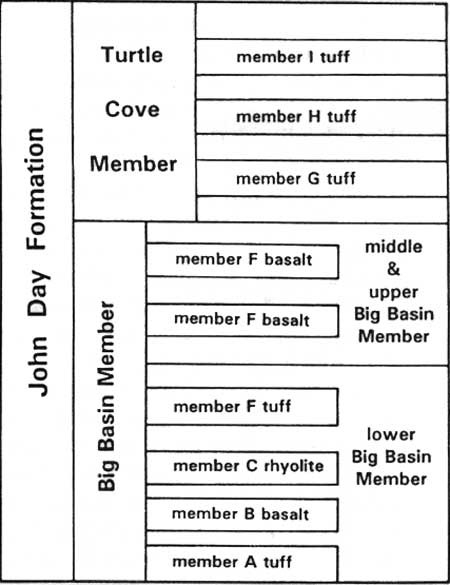
|
| Figure 2.15. Stratigraphy of the John Day Formation in the Clarno Unit area. |
Welded tuff of member A. Rhyolitic pyroclastic volcanism of the John Day Formation is first recorded in north central Oregon by an ash-flow tuff now re-dated in the Clarno area at 39.2 Ma by Carl Swisher as part of this project. This basal ash-flow tuff sheet is extensively exposed in the western facies (Peck, 1964; Robinson, 1975). The distinctive and widespread ash flow tuff of member A is useful in delineating the Clarno surface at the onset of John Day volcanism.
A lower, densely welded tuff forms prominent outcrops in the Clarno Unit area and is approximately 30 m thick. Locally near the base of the unit is a perlitic vitrophyre which is best exposed in a roadcut at the Gables. At the very base of the ash-flow tuff are unwelded tuff deposits some containing accretionary lapilli and plant remains (Fig. 2.14d). Lithic fragments are common in the lower tuff as are bi-pyramidal (beta) quartz crystals. The tuff, where densely welded, has a red-purple color.
An upper, weakly welded to unwelded ash flow tuff, approximately 25 m thick, crops out extensively in the Clarno Unit area where it commonly forms the dip slope on the member A cuesta. This unit also contains abundant bi-pyramidal quartz crystals but less lithic fragments than the lower densely welded part. Fluvially reworked beds occur in places such as in upper Indian Canyon area where concentrations of bi-pyramidal quartz and feldspar crystals derived from the underlying tuff occur.
The two part division of member A in the Clarno Unit area is consistent with member A stratigraphy in more complete sections to the west (Robinson and others, 1990). Near Ashwood, the tuff consists of a basal and upper ash-flow tuff sheet, both welded and approximately of similar crystal content (Robinson and others, 1990). Between the two ash-flow sheets lies a complicated stratigraphic package of reworked tuffs, tuffs of airfall origin and tuffs containing plant remains (Robinson and others, 1990).
Member B basaltic andesite. In the Clarno Unit area, distinctive aphanitic basaltic andesite flows overlie member A. Red claystones are locally present between the two units, although exposure of this thin interbed is poor. The flows consist of aphanitic to sub-glassy basaltic andesite that weather into cobble-sized blocks. These basalts correlate with the member B trachyandesites of Peck (1964) which form a thick unit in the Ashwood area (Swanson, 1969), but has also been mapped in the Clarno Unit area (Robinson, 1975). Peck (1964) identified 1,500 ft of very dark gray aphanitic flows of trachyandesite in the Ashwood area. These basaltic andesite flows of member B of the John Day Formation are widespread in the western facies (Peck, 1964; Robinson, 1975) and occur as flows and dikes in the Clarno Unit area. In the Clarno Unit area a 21 m thick columnar jointed basaltic andesite lava flow crops out at the head of Indian Canyon and is the thickest occurrence of member B in the area. Other small exposures are scattered throughout the area and are recognizable by their aphanitic texture and small cobble-sized weathering character, similar to Peck's (1964) description of member B. A set of basaltic andesite intrusions of this lithology forms a small hill between Hancock Canyon and Indian Canyon (NE 1/4 of sec. 26). The rock contains pebble-sized cognate xenoliths of gabbro. The geochemistry of lava flows and dikes of this unit are discussed and compared to other basaltic units in the area later in this chapter.
Member C rhyolite. In the Clarno area, there are very limited exposures at the head of Indian Canyon of rhyolite flows stratigraphically above the member B basalt flow. Here the rhyolite caps the eastern part of the cuesta and forms a weathered, cobbly outcrop. Rhyolite of member C forms 1,000 ft thick rhyolite dome and flow complexes north of Ashwood (Peck, 1964).
White tuff of member F. A massive white vitric tuff approximately 1-3 m thick is widespread but poorly exposed in the lower John Day Formation in the Clarno area. Robinson and Brem (1981) identified a massive white vitric tuff located in a roadcut just west of Clarno Grange on Highway 218 as the base of member F in this area. This white vitric tuff is low in the John Day Formation and interbedded with clayey red beds and has been mapped in the Clarno Unit area and is referred to as member F tuff (Plate I, II). However, according to Peck (1964), the weakly welded ash flow tuff that defines the base of member F is not a widespread unit making the correlation of this tuff in the Clarno area with the type area of the western facies questionable. The member F tuff further west toward Ashwood is crystal poor as is the tuff in the Clarno area. Robinson (1975) mapped member F units in the Clarno area and Robinson and others (1990) define member F as a group of heterogenous tuffaceous sedimentary rocks that lie between the ash-flow sheets of E and G and commonly contain olivine basalts toward the top of the unit. The vitric tuff referred to here as member F tuff was dated at the "Whitecap Knoll" locality by Carl Swisher at 38.2 Ma, considerably older than previously thought (Getahun and Retallack, 1991). Getahun and Retallack (1991) identified an Alfisol-like paleosol (Luca pedotype) directly below this tuff at "Whitecap Knoll" and referred to this part of the section as Oligocene in age.
Lower Big Basin Member claystones. Widespread, thick clayey red beds in the lower part of the John Day Formation in the Clarno Unit area are mapped as Big Basin Member based on lithologic and stratigraphic similarities with the type section of this member in the Big Basin area of Picture Gorge. Recently recognized subdivisions of this member in a reference section from the Painted Hills area (Bestland and others, 1993; Bestland and others 1994; Bestland and Retallack, 1994) are also recognized in the Clarno Unit area (Fig. 2.16).
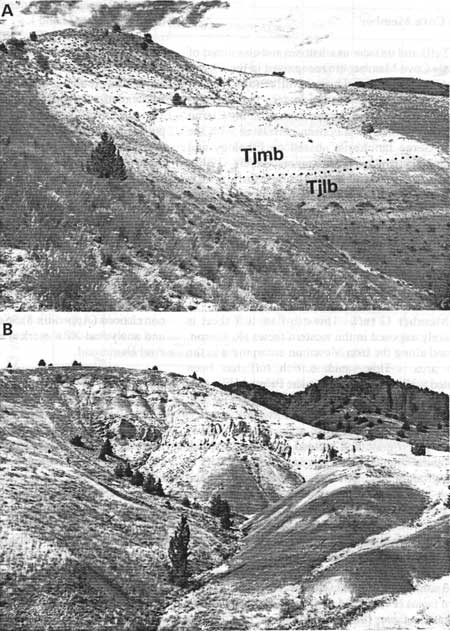
|
| Figure 2.16. Photographs of lower and middle Big Basin members of the John Day Formation. Figure 2.16A. Contact between strongly developed red paleosols of the lower Big Basin Member (Tjlb) and lapilli tuffs and moderatley developed paleosols of the middle Big Basin Member (Tjmb) at "Italian Hill." Figure 2.16B. Moderately developed red-brown paleosols of the middle Big Basin Member in the foreground and cliff-forming tuffaceous channel complex. This locality is 300 m north of the "Slanting Leaf Beds." |
The John Day Formation in the Clarno Unit area contains a thick section of late Eocene strata, as indicated by our new 38.2 Ma and 33.6 Ma age determinations from this area. These late Eocene paleosols are not dominated by colluvial reworked and lateritic paleosols as are the paleosols of this age in the Painted Hills and Big Basin areas. This part of the John Day basin was probably a floodplain depocenter during the late Eocene, rather than a colluvial slope on the south side of the Blue Mountains uplift.
Middle and upper Big Basin Members
The middle and upper Big Basin Members were not delineated in the Clarno area as they were in the Painted Hills (see the Painted Hills report). In the Clarno area, red-brown silty claystones, tuffs, and lacustrine shales with leaf impressions, similar to strata in the Painted Hills area identified as middle Big Basin member, occur above clayey red beds identified as the lower Big Basin Member and below green tuffaceous strata of member G containing the sanidine tuff (Fig. 2.15). This tuff occurs in the lower part of the Turtle Cove Member in the Painted Hills where it was dated at 29.8 Ma. Additionally, the 33.6 Ma age determination from the "Slanting Leaf Beds" and the well documented Bridge Creek flora (Meyer and Manchester, 1994) from these strata allows correlation with the middle Big Basin Member. In the Painted Hills area age determinations on tuff beds of 33.0 Ma and 32.7 Ma are associated with the type locality of the Bridge Creek flora and are contained within the middle Big Basin Member. Red silty claystones stratigraphically above the "Slanting Leaf Beds" and below a prominent tuffaceous channel complex (Fig. 2.16B) are similar to Ticam and Skwiskwi pedotypes identified in the middle and upper Big Basin members from the Painted Hills.
Conglomerates containing weathered clasts of tuff and igneous flow rocks are locally present in the Clarno area at the base of the middle Big Basin Member (Fig. 2.1). In gullies to the west of the "Slanting Leaf Beds", brown calcareous paleosols overlie these conglomerates and underlie the lacustrine and carbonaceous shales of the "Slanting Leaf Beds".
A large exposure of red, brown and green claystones and tuffaceous claystones at "Italian Hill", is the longest and most continuous section of the lower and middle Big Basin Members in the Clarno area (Fig. 2.16a, Plate I and II). The section contains four fairly resistant and fresh pumice lapilli tuffs that contain feldspar crystals. The section may contain the Eocene-Oligocene boundary based on comparison with lithologies of paleosols associated with the "Slanting Leaf Beds" section dated at 33.6 Ma and the "Whitecap Knoll" section dated at 38.2 Ma. Lateral tracing of the package of red, clayey paleosols and vitric tuffs of the "Whitecap Knoll" section indicates that the lower part of "Italian Hill" is probably lower Big Basin Member. Lateral tracing of the "Slanting Leaf Beds" is more difficult, but preliminary inspection indicates that the upper half of "Italian Hill" with its pumice lapilli tuffs and paleosol types correlates with the middle Big Basin Member.
Turtle Cove Member
Tuffs and tuffaceous siltstones and claystones of the Turtle Cove Member are recognized in the Clarno Unit area based on correlation of tuffs in the western facies with this member in the eastern facies. Ash-flow tuffs of member G, H, and I occur in the Clarno Unit area. Member H has been correlated with the "Picture Gorge ignimbrite" based on lithology and stratigraphic position (Robinson and others, 1990). The Turtle Cove Member as well as the ash-flow tuffs of member G, H, I do not occur in the project area, however, they are exposed just to the north of the project area in The Cove and have been mapped previously by Robinson (1975) and by Bestland, Blackwell and Kays (unpublished mapping 1986 and 1988). These units are significant in the context of correlating the Turtle Cove Member of the John Day Formation.
Member G tuff. This ash-flow tuff sheet is extensively exposed in the western facies (Robinson, 1975) and along the Iron Mountain escarpment in the Clarno area. This sanidine rich tuff has been correlated with a sanidine tuff in the Painted Hills area (Hay, 1963; Woodburne and Robinson, 1977) which has been recently dated at 29.8 Ma by Carl Swisher. In the Clarno area the tuff is 1-6 m thick, gray, yellow-gray and green-gray, non-welded to weakly welded, and contains abundant sanidine and quartz crystals in a vitric groundmass. A distinctive set of green and greenish-blue tuffaceous claystones and siliceous claystones occurs above the sanidine bearing tuff. Locally in The Cove, this section contains beds rich with snails (locality L1354 of Appendix 9).
Member H tuff. Above the greenish tuffaceous deposits is a thick (10-20 m), light brown, fine-grained welded ash-flow tuff sheet that is widespread in the western facies (Peck, 1964; Robinson, 1975) as well as in the eastern facies (Fisher, 1966) where it is referred to as the "Picture Gorge ignimbrite." Two recent age determinations of this unit in the Painted Hills are both 28.7 Ma (dates by Carl Swisher, reported in Bestland and others, 1993). This tuff is crystal poor and contains variable amounts of lithic fragments of rhyolite and tuff. Two cooling units are present in the Clarno area as has been recognized in the eastern facies by Fisher (1966). To the west of Clarno, closer to the source, only one cooling unit is recognized (Robinson and others, 1990). In cliffs below the Columbia River Basalt Group on Iron Mountain, member H tuff is commonly overlain directly by the member I ash-flow tuff sheet with no intervening sedimentary deposits. Elsewhere in the western facies, tuffaceous sedimentary deposits occur between the tuffs of member H and I.
Member I tuff. In the Clarno area, this distinctive coarse-grained ash-flow sheet occurs in scattered exposures high on the slopes of Iron Mountain. It was eroded in most places prior to the accumulation of the Columbia River Basalt Group. The tuff is up to 15-20 m thick and contains coarse pumice fragments, coarse vitric shards, and obsidian fragments. Where the base of the unit is exposed, these pebble-sized obsidian fragments are vaguely cross-bedded and may represent the basal surge of the ash-flow.
GEOCHEMISTRY OF LAVA FLOW AND TUFF UNITS
Sixty Clarno Unit igneous and tuff samples were analyzed for whole rock geochemistry in order to characterize these units and aid with stratigraphic correlations (Appendix 8). Selection of rock samples and analytical XRF work was done with the help of Paul Hammond.
Basaltic lava flows
Basaltic units in the upper Clarno and lower John Day formations are distinguishable on the basis of both their lithology and bulk rock geochemistry (Fig. 2.17). Three lithostratigraphic basalt units are recognized: 1) amygdaloidal basalt in the conglomerates of Hancock Canyon, 2) member B trachy-andesite or basaltic-andesite in the lower John Day Formation, and 3) alkalic basalts also in the lower John Day Formation although stratigraphically higher than member B (Fig. 2.1). Analyses of basaltic rocks from the lower John Day Formation by Robinson (1969), Robinson and others (1990), Hay (1962a), Taylor (1981) are compared to whole rock data from Clarno Unit basaltic rocks (Fig. 2.17).
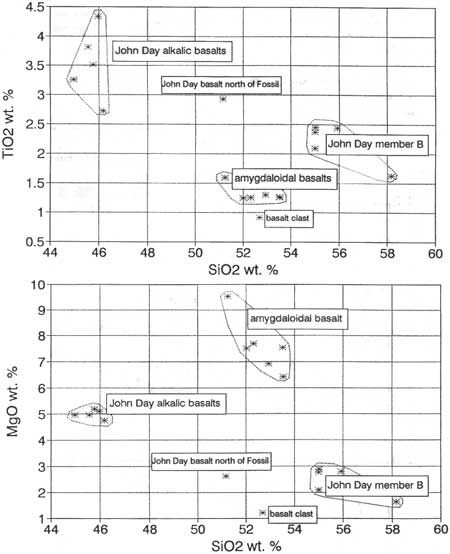
|
| Figure 2.17. Scatter plots of XRF whole rock data of basalt flow from the upper Clarno and lower John Day Formation in the Clarno Unit area.(click on image for an enlargement in a new window) |
The amygdaloidal basalt is stratigraphically in the upper part of the conglomerates of Hancock Canyon and is the stratigraphically lowest of the basaltic units discussed here. The basalt is an important local marker unit which ties the conglomerates of Hancock Canyon in the Clarno area with Clarno Formation units south along the John Day River. The unit has been identified further to the south along the John Day River on the north side of Melendy Ridge (sec. 26, R19E, T8S) across from Bowerman's ranch. The lithology and distribution of this unit is covered in the stratigraphy section. The unit is a high-silica basalt to basaltic andesite in major element composition. The most mafic of the six samples analyzed is from the "West Face Cliffs" where the flow is thickest (26 m). All other samples are from the north side of Pine Creek. The sample labelled basalt clast, collected by Paul Hammond, is from a conglomerate bed to the west of Hancock Field Station in the upper part of the conglomerates of Hancock Canyon. The correlation of this basalt flow in the Clarno Unit area with the laterally extensive exposures of the amygdaloidal basalt to the south in the "West Face Cliffs" is well established by this lithologic and geochemical data.
The second group of basaltic rocks occurs in the lower John Day Formation as discontinuous lava flows stratigraphically just above member A welded tuff. Small intrusive bodies at hill 2148 (NE 1/4 sec 26) intrude Clarno Formation units and have very similar lithology and geochemistry as the lava flows. These basaltic andesites or trachyandesites compare well with member B lavas extensively exposed near Ashwood in the lower John Day Formation (Peck, 1964; Robinson 1975). The prominent lava flow above the welded tuff of member A at the head of Indian Canyon, mapped as member B basalt, is somewhat richer in SiO2 than both the intrusive rocks and an average trachyandesite composition from Robinson and others (1990).
The third group of basaltic rocks also occurs in the lower John Day Formation, although at a significantly higher stratigraphic level than member B basalts. These lava flows are alkalic basalts and are known from the lower John Day Formation in both the western and eastern facies (Hay, 1962; Robinson, 1969). In the Clarno Unit area, one sample of the stratigraphically lowest occurrence of these basalts was analyzed (Fig. 2.17). This basalt caps the ridge above the "Slanting Leaf Beds" fossil site. These member F basalts, using the terminology of Robinson (1975), are extensively exposed stratigraphically higher on the flanks of Iron Mountain and in The Cove.
Geochemistry of andesitic units
The geochemical compositions of the two major andesite units (andesite of Pine Creek and the andesite of Horse Mountain) in the Clarno Unit area are largely indistinguishable (Figures 2.18 and 2.19). Both units are typical of Clarno Formation convergent margin andesites and show chemical characteristics, such as K2O content, indicative of thin continental margin settings (Rogers and Novitsky-Evans, 1977). Several geochemical features of the andesites allow smaller groupings to be made (Fig. 2.18). The andesite of Pine Creek is more compositionally homogeneous and more strictly andesite than the andesite of Horse Mountain. The samples of andesite of Pine Creek from the center of the project area are very similar in composition and slightly more mafic than the andesites of Horse Mountain. These basaltic-andesites contain 4 to 5 times the Cr and Ni of other analyzed andesite samples.
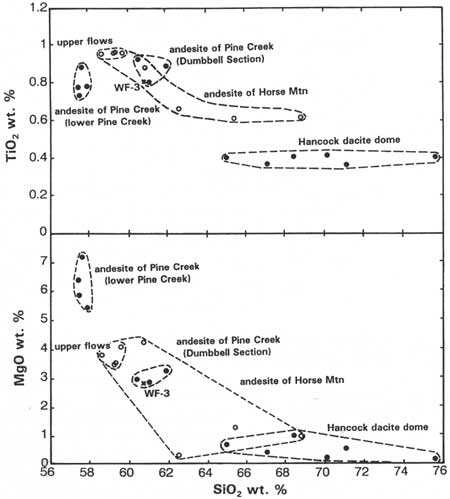
|
| Figure 2.18. Scatter plots of selected major elements from XRF whole rock data of andesitic igneous rocks in the Clarno Formation. (click on image for an enlargement in a new window) |
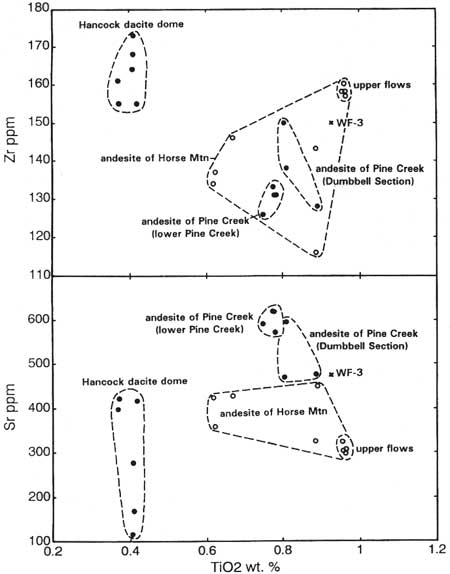
|
| Figure 2.19. Scatter plots of Zr and Sr vs Ti in andesitic igneous rocks from the Clarno Formation. (click on image for an enlargement in a new window) |
The andesite of Horse Mountain ranges from andesite to dacite (Fig. 2.18). Four samples of the andesite of Horse Mountain are compositionally very similar and include two samples of platy andesite from hill 2066, a sample from the nearby hill to the north in the center of sec. 26, and a sample from an andesite flow in the upper part of the lava flow package of Horse Mountain, above the massive cliff-forming flows and identified as upper andesite unit discussed below. These are probably the same flow unit. On top of Horse Mountain (NE 1/4 of sec 10), a couple of meters of red beds (strongly developed paleosols) lie between the andesite of Horse Mountain proper and this upper andesite unit (see Plate I). Thus, the massive cliff-forming flow of Horse Mountain is not the small flow as the andesite capping hill 2066.
Six of the least altered samples of the Hancock Dome were analyzed. Five of the samples are in the dacite range and one, containing 75% SiO2, is clearly rhyolitic (Fig. 2.18). The range in silica values may be due to non-homogenous parent material, hydrothermal alteration, or deep tropical weathering. The TiO2 content does not vary with SiO2 contrary to the expected trend of decreasing TiO2 with increasing SiO2 which would be expected from normal igneous processes of crystal differentiation. Low temperature hydrothermal alteration or deep weathering would produce leaching of mobile bases (Na2O, K2O and CaO), while keeping TiO2 values constant. However, Na2O and K2O do not change significantly whereas CaO does. The great change in CaO values in the sample with the highest SiO2 probably reflects lack of abundant Ca-feldspar and so the variation in the Hancock Dome is probably due to original heterogeneities in the plagioclase content of the igneous body.
Geochemistry of tuffs
Thin and laterally discontinuous tuff beds are common in the volcaniclastic strata of the Clarno Unit area. Most tuff beds occur in the conglomerates of Hancock Canyon and include stony reworked tuff beds and thin white vitric tuff beds. There is also a welded tuff (Muddy Ranch Tuff or Rajneesh Tuff of Vance, 1988) in the upper part of the conglomerates of Hancock Canyon thought to correlate with an extensive tuff sheet in the Muddy Ranch area and dated at 44 Ma by Vance (1988). Additionally, the upper, poorly welded, white part of the John Day member A tuff was analyzed in order to differentiate it from similar-appearing white tuffs in the upper Clarno Formation. Many of the tuffs have been reworked and contain admixtures of volcanic rock fragments which has changed their original composition. However, several correlations are possible from the analyses of these 21 tuff samples (Fig. 2.20; Appendix 8).
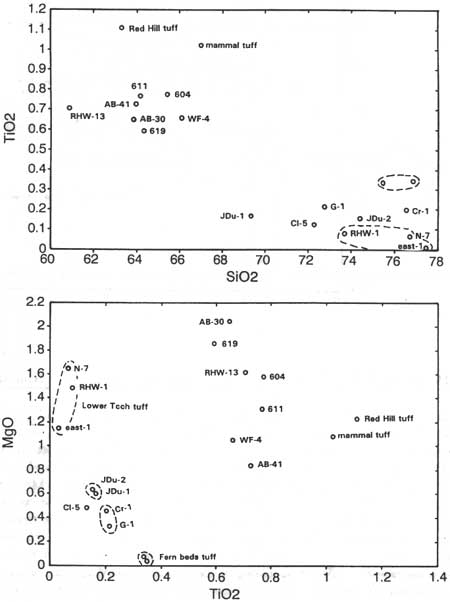
|
| Figure 2.20. Scatter plots of XRF whole rock data of rhyolitic tuffs from the Clarno Formation in the Clarno Unit area. (click on image for an enlargement in a new window) |
Two samples of the Muddy Ranch tuff were analyzed; one from the welded portion of the thick tuff sequence in the eastern part of the Muddy Ranch valley along Current Creek (south-central portion of sec. 34, T8S, R18E) and one sample of a welded tuff in the upper part of conglomerates of Hancock Canyon at the Gables. These two tuffs are rhyolitic, compositionally consistent, and have significant Ba and Sr contents that are much higher than most Clarno tuffs. The "Fern Quarry Tuff" also contains significantly lesser amounts of Sr and Ba. Tuff sample C1-5 which crops out in the upper part of the conglomerates of Hancock Canyon, is possibly correlative to the Muddy Ranch Tuff. Two samples of the upper John Day member A were also analyzed (Fig. 2.20) and have similar compositions to the Muddy Ranch Tuff. Another possible correlation is the tuff bed at the base of the "Nut Beds" section (lithic tuff at 27 m lever of Fig. 11) with the tuff at the base of the "Red Hill West" section (Fig. 2.12). These tuffs are referred to as the lower Tcch tuff in Figure 2.20. Other tuffs in the conglomerates of Hancock Canyon have similar but variable compositions that restrict correlations between the sections in the upper part of the Clarno Formation. Vivid green tuffs occur at scattered localities in the Clarno Unit area, however, geochemical analyses of a few of these tuffs has so far not revealed any correlations.
STRUCTURE OF CLARNO UNIT
AREA
The Clarno Unit-Hancock Field Station area can be divided into two areas based on structure: 1) relatively flat-lying strata of Horse Mountain, and 2) these same strata folded along a NE-SW fold limb. Other smaller folds are present in the area, however, the NE-SW fold dominates the local structure. This fold has the same orientation as the Muddy Ranch dome (Robinson, 1975), to the southwest of the project area. The fold dies out in the northeastern part of the project area (Fig. 2.2). In the Clarno Unit area, the geologic sequence is complicated by this NE-SW fold limb, intrusion of a dacitic dome, another small structural dome, and laterally variable volcanic facies.
Supporting evidence that this structural dome exposes older Clarno units is the identification by Hammond (pers. communication, 1993) of strata underlying the andesite of Pine Creek flow unit, thus documenting that "lower Clarno lahars" underlie this andesite. Mapping of individual lahar units in this lower unit by Hammond as well as strike and dip measurements define a partial domal structure (Plate II). Because the "lower Clarno lahars" have a much different structural signature than the overlying strata (see following section), and are intruded by hornblende dacite, the intrusion of the hornblende dacite, either as a subsurface intrusion or as a viscous surface dome, probably domed the surrounding country rock. Later erosion, deposition and folding has masked much of this relationship. This older sequence is only found around the dacite dome and has not been correlated to other units in the area.
The Clarno Formation above the level of the hornblende dacite dome consists of a series of debris flow aprons variously interrupted by lava flows and minor ash falls and flows. Separating the laharic debris flows from the Mammal Quarry conglomerates and siltstones and andesite of Horse Mountain is the thick sequence of floodplain paleosols in "Red Hill" which represent a profound break in volcanism and hiatus of voluminous coarse-grained volcanogenic sedimentation. Volcanogenic sedimentation again resumed with the eruption of the large and extensive andesite of Horse Mountain and the corresponding deposition of the "Mammal Quarry" beds.
Structural analysis of folded strata
Structural analysis of the folded strata of the Clarno Unit has revealed an episode of relatively inconsistent folding of the area. Strike and dip measurements from the Clarno Unit were grouped into subareas (Table 2.3). These subareas were defined according to their stratigraphic position and structural homogeneity. Wulff net or bottom hemisphere plots is a common technique used to analyze folded strata from strike and dip measurements.
TABLE 2.3. Strike and dip measurements of the Clarno Formation
| "Bat Barn Area" | "Indian Mesa Area" | "Core of Dome" | |
| lower section | upper section | ||
| N35W 12W | N10W 12SW | S30W 18E | N58W 8S |
| N33W 11W | N15W 11SW | S5E 15E | N45E 32N |
| N40W 12W | N25E 23SW | S35E 19N | N37E 34N |
| N20W 10W | N15E 22SW | S25E 20N | N15E 17W |
| N10W 30S | N15W 33SW | N65E 21N | N22E 18W |
| N50W 26S | S10E 10E | N15W 30SW | S30E 10NE |
| N3OW 16SW | N60W 4N | ||
| N28W 13SW | S80W 7N | ||
| S45W 13N | |||
Based on field observations, the folded strata in the Clarno Unit are non-homogenous; that is, their orientation has not just been caused by a parallel, single folding event. Their orientations may result from superposed folds, or by fault-block tilting of folded strata. The oldest strata in the area (Lower Clarno lahars of Figure 10) have scattered plots which do not define a fold axis or axial fold plane (Fig. 2.21a). In map view, however, these strata and their strike and dips, define half of a dome. Up-section in the "Bat Barn" area, two subareas have been defined according to their stratigraphic position and homogenous strike. The lower section strike and dips (Figure 2.21b) define a fold axis that trends approximately 52°E and plunges 8° to the S (Figure 2.21b). The upper section has a less well defined axis which trends S39°W and plunges 5° SW (Figure 2.21b).

|
| Figure 2.21. Stereographic plots of structural data from the Clarno Unit area. Figure 2.21A. Strike and dips from the lower Clarno conglomerates. The non-linear scatter of points is consistent with a shallow angle dome structure. Figure 2.21B. Strike and dip measurements from conglomerates of the "Palisades" and conglomerates of Hancock Canyon from the west side of the structural dome (Plate II). Figure 2.21C. Strike and dip measurements from "Indian Mesa" and including both conglomerates of the Palisades and conglomerates of Hancock Canyon. Data defines a fold axis trending N31°E and plunging 9° NE. |
The preferred conclusion is that there is a diffuse northeast-southwest trend to these folded rocks, except for the "Lower Clarno lahars" which, at this level of analysis, do not have a clear fold axis orientation. A northeast-southwest axial plane defined in Fig 2.21 is consistent with the northeast-southwest trend of member A in this area.
SEDIMENTATION AND VOLCANISM
Clarno Formation depositional setting
The Clarno Formation sedimentary units in the project area can be broadly grouped into coarse grained debris flow dominated deposits and fine grained, alluvial paleosol or overbank deposits. Lacustrine shales and lacustrine delta deposits are significant locally, however, sedimentary deposits in the Clarno Formation are dominated by conglomeratic debris flow and coarse-grained fluvial deposits (White and Robinson, 1992; Bestland and others, 1994a, b). Fine-grained overbank deposits and paleosols are common in the formation, however due to the poor exposure of these claystone units, the distribution and sedimentology of these units has been largely ignored (Robinson, 1975; Swanson, 1969) except in a few places such as "Red Hill" (Retallack, 1981; 1991a) and in the Cherry Creek area where White and Robinson (1992) briefly describe a thick section of clayey red beds.
The coarser-grained deposits in this area, notable the lahars of the Clarno Formation and the pyroclastic deposits of the John Day Formation, have received some attention. White and Robinson (1992) interpret the coarse-grained Clarno Formation deposits as proximal, non-marine lahar aprons and reworked fluvial deposits that flanked stratovolcanoes, possibly in fault-bounded mini-basins in a tensional arc setting, similar to the Quaternary High Cascade graben of the central Oregon Cascades (Taylor 1990, Smith and others, 1987).
Coarse-grained, non-marine volcaniclastic deposits display a continuum between debris flow and stream flow depositional features (Nemec and Muszynski, 1982; Smith, 1986; Scott, 1988). The continuum exists largely because of rapid transformations that occur between the various flow types. Scott (1988) documents flow transformations from pyroclastic flows to debris flow, debris flows to hyperconcentrated flood flows, and flood surge to lahar based on the deposits and sedimentation records of the 1980 Mt St Helens eruption. These modern examples are important for the understanding of Clarno Formation debris flow deposits. For example, a common deposit combination in the formation consists of a thin layer of vaguely bedded pebbly conglomerates at the base of massive debris flows such as occurs at the base of the lahar containing the "Hancock Tree." The vaguely bedded, granular or pebbly sandstones common in the Clarno Formation have grain to grain contact and stringers of coarser clasts indicating deposition by traction current (Fig. 2.22a). However, cross-bedding or climbing bedforms are missing, indicating that these are not normal fluvial deposits. Deposits such as these have been recognized as an intermediate between fluvial and debris flow processes and referred to as hyperconcentrated flood flow deposits (Smith 1986; Nemec and Muszynski, 1982). In the Mt St Helens case, Scott (1988) documents "bulking" of traction flood surges into debris flows by the incorporation of debris from the fluvial channel by hyperconcentrated floods. The flood surge then precedes the debris flow and produces the depositional package of hyperconcentrated flood deposit with overlying debris flow deposit. In the case of Mt St Helens, the flood surge was caused by the rapid melting of the snow pack and glacial ice by hot pyroclastic debris. In the case of a volcano in a humid tropical setting, the stripping of vegetation followed by a large rainfall event (possibly eruption induced) can trigger such flood surges. Bulking of flood surges and the corresponding erosion is more likely to occur in the high gradient landscape positions (high on the alluvial apron) and deposition of the debris flow and associated deposits occurs on lower gradient apron positions.
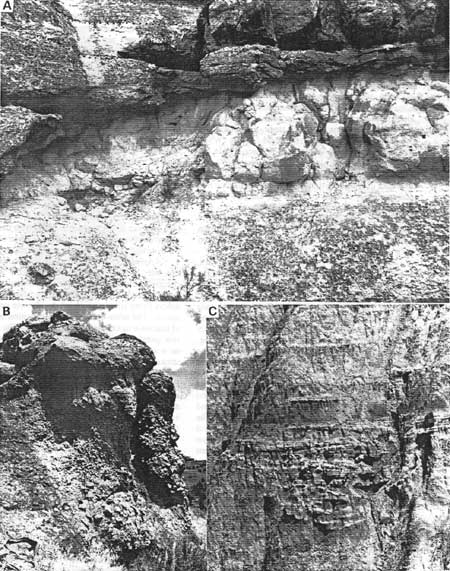
|
| Figure 2.22. Photographs of volcaniclastic deposits in the Clarno and John Day Formations. Figure 2.22A. Hyperconcentrated flood flow deposits onlapping eroded paleosol (Sayayk pedotype) in the conglomerates of the "Palisades" in the "Palisades Cliffs." Figure 2.22B. Clast-supported debris flow deposit in the conglomerates of Hancock Canyon. Figure 2.22C. Example of a sandy channel deposit in the John Day Formation, Turtle Cove Member, Logan Butte. Backpack on the right side of channel gives scale. |
Another common feature in the coarse-grained deposits of the Clarno Formation are clast-rich channelized debris flows. In the south facing part of the "Palisades Cliffs," clast-rich and clast-supported debris flows fill channels cut deeply into underlying lahars. The lahar layers and superposition or nesting of channels in this locality is complex. The resulting stratigraphy consists of laterally discontinuous layers on a scale of 10's of meters that contain protruding sticks and logs. Scott (1988) documents channel facies debris flows from the deposits of the 1980 Mt St Helens eruption. These channel facies debris flows are commonly clast supported, sit on an eroded pavement, are localized to the channel area, have protruding logs and sticks and have large-scale longitudinal bar features referred to by Scott (1988) as whale back bars. These channel facies debris flows contrast with floodplain debris flow facies. Floodplain facies debris flows are clast-poor, relative to channel facies, have non-erosive bases commonly with hyperconcentrated flood flow deposits, forest litter, standing trees as well as protruding sticks and logs and lateral continuity of single debris flows. This debris flow facies has a high preservation potential due to lateral continuity and lower chance of fluvial reworking compared to channel facies. Scott (1988) also documents debris flow recession, whereby a "high water mark" is achieved that is significantly higher than the resulting deposit. This process encourages deposition in relatively elevated floodplain or low terrace settings and also causes the pre-debris flow topography to be mantled. Thus, subsequent fluvial channels tend to be located preferentially where the channel facies debris flows were deposited causing superimposed channel complexes (nested channels).
There is a distal-proximal component to channel and floodplain facies debris flows. Proximal to the volcano on the debris flow apron, nearer the apex, channel facies debris flows and fluvial incision and reworking of debris flow deposits are more common. Distal from the volcano and on lower gradient apron settings, floodplain debris flow facies are widespread. Here, fluvial incision and reworking of debris flow deposits also occurs, however, these fluvial conglomerates have a greater preservation potential than on higher gradient areas where syn-debris flow erosion (bulking) is a common process.
These concepts can be applied to the two mapped debris flow packages in the Clarno area to make the following interpretations. The conglomerates of the Palisades are generally coarse grained through-out the mapped area and contain very coarse-grained channel facies debris flow deposits in the "Palisade Cliffs". Such a large debris flow apron with little proximal-distal clast size distribution and largely lacking fluvial conglomerates probably represents a large alluvial apron which flanked a large volcano. If this were a braidplain, then fluvial conglomerate beds would be interbedded with debris flows. This interpretation supports the conclusion of White and Robinson (1992) that the Clarno Formation volcaniclastic deposits accumulated in volcanic flank and apron settings, but is an exception to the conclusion of White and Robinson (1992) who concluded that the volcanoes responsible for Clarno Formation deposition were small. Conglomerates of Hancock Canyon have a mix of debris flow deposits, fluvial conglomerates and tuff beds. The abundance of flood surge or hyperconcentrated deposits and fluvial reworking indicate a lower gradient or more distal depositional setting than the conglomerates of the "Palisades." Additionally, the mixed nature of the deposits with their numerous thin tuff beds indicates a braidplain setting. Lateral variation of this conglomerate unit from a mixed debris flow and fluvial package with tuff beds to a package of coarser grained debris flows from west to east indicates an apron to braidplain transition in this direction.
Coarse-grained volcaniclastic deposits commonly contain sedimentary features indicative of formation during and immediately after volcanic eruptions and also can be interpreted as a record of the volcanic events or even eruptive history of individual volcanoes (Williams and McBirney, 1979; Fisher and Schmincke, 1984; and Cas and Wright, 1987). Proximity and direction to source volcanoes has been worked out in a number of ancient examples (Palmer and Walton, 1990; and Waresback and Turbeville, 1990, to name just a few) using sedimentologic data from modern analogues such as Volcan Fuego, Guatemala (Vessel and Davies, 1981) and Ruapehu, New Zealand (Hackett and Houghton, 1989). The Clarno Formation debris flow packages are similar to previously described proximal apron packages (Palmer and Walton, 1990; Waresback and Turbeville, 1990) interpreted as syn-eruptive deposits associated with explosive eruptions. In these cases explosive eruptions produced abundant sand and gravel-sized debris that was initially transported as small block and ash pyroclastic flows and as more widespread fallout layers as at Mt. St Helens in 1980. These types of eruptions are common on andesitic to dacitic volcanoes where they blanket the landscape with ash, kill the plant cover and add moderate volumes of fragmental debris to the headwaters of streams. This material is rapidly redistributed to form alluvial plains that surround the erupting volcano. Build-up of these encircling alluvial plains gives rise to apron facies (alluvial fan equivalent) and arena or ring plain facies (braidplain equivalent) volcaniclastic successions (Pickford, 1987). In practice, the apron and arena facies commonly overlap due to far-traveled coarse grained, eruption-induced aggradational events (Scott, 1988).
The coarse-grained debris-flow-dominated sedimentary units in the Clarno Formation are interpreted as the product of syn-eruptive sedimentation (White and Robinson, 1992; Bestland and others, in press). The debris flow units are laterally continuous and mappable for 5-15 km in the Clarno area and onlap hilly topography to form an upper planar surface. The geometry and rapidly deposited sets of debris flows with little reworking is evidence for debris flow aprons. Sets of debris flows with no paleosol interbeds are common in these debris flow packages. These sets of debris flows are separated by weak to moderately developed paleosols whereas the mappable debris flow packages such as the conglomerates of the Palisades and the conglomerates of Hancock Canyon are separated by well-developed paleosols. The debris flow sets are interpreted as syn-eruptive sedimentation from one eruptive episode and the whole mappable debris flow package probably represents the main eruptive period of a medium-sized volcano.
In the Clarno area tracing of the debris flow apron deposits into proximal and vent facies has been done thus far only at Keyes Mountain (Oles and Enlows, 1971). The lack of a regional stratigraphic framework and marker units in the Clarno Formation has hampered efforts to identify more eruptive centers. High weathering rates in a humid climate may have destroyed much of the constructional central vents of these Eocene volcanoes.
White and Robinson (1992) report from their summary of the sedimentological characteristics of the Clarno Formation that much of the deposits have features consistent with deposition in lowlands flanking large central vent volcanoes at distances of 10-50 km. Therefore, White and Robinson (1992) conclude, as do previous workers (Oles and Enlows, 1971 and others), that the Clarno Formation represents the deposits of an active volcanic arc. The lack of systematic variation in the sedimentary deposits of the Clarno Formation is interpreted by White and Robinson (1992) to represent deposition in braidplains around small volcanoes. Large volcanoes should have produced distal-proximal facies relationships in the coarse-grained sequences. This conclusion of White and Robinson (1992) is premature. Lateral stratigraphic and sedimentologic work on a coarse grained unit in the Clarno Formation was not done by White and Robinson (1992). The complexity and juxtaposition of volcanic units and facies is probably the reason that this type of lateral work was not attempted by White and Robinson (1992). During the course of the present study, the two conglomerate units identified in the Clarno Unit area were mapped over a lateral distance of 10-15 km (Fig. 2.23). The conglomerates of Hancock Canyon change from a mixed fluvial-debris flow package in the western part of the project area to a package of debris flows in the eastern part of the area. The distribution of tuffs and other beds is interpreted as apron to braidplain depositional setting. The conglomerates of the Palisades is a homogenous coarse-grained debris flow package which has some variations from channel to overbank facies but no obvious lateral grain-size change. In this debris flow package, a thick resistant lahar bed (8 m thick) can be traced for 5 km. This type of large volume debris flow probably originated from a large volcano. Other evidence of large volcanoes in the Clarno Unit area are the large volume, laterally continuous andesite units such as the andesite of Horse Mountain (Fig. 2.23). This unit was probably part of an andesite shield volcano.
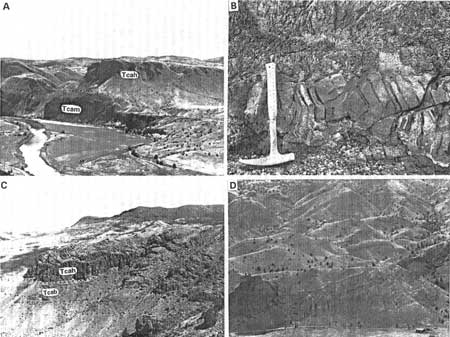
|
| Figure 2.23. Photographs of lava flow features in the Clarno Formation. Figure 2.23A. Intracanyon andesite flow of the middle andesite unit (Tcam) exposed along the John Day River south of Clarno. Figure 2.23B. Pipe vesicles in the base of amygdaloidal basalt flow in the "West Face Cliffs" (flow direction is from right to left or towards the northwest). Figure 2.23C. Ramp structures in the cliff-forming flow of the andesite of Horse Mountain, at "West Face Cliffs." Figure 2.23D. Vent facies in the Clarno Formation consisting of steeply dipping coarse pyroclastic strata. Locality is on the east side of the John Day River from Melendy Ridge. |
Depositional setting of fossil sites in conglomerates of Hancock Canyon. Within the Clarno area are numerous fossil plant localities (including several new sites, Appendix 9) that indicate apparently dissimilar climates. The classic "Nut Beds" site yields plant fossils strongly indicative of a tropical to paratropical climate (Manchester, 1981, 1994). In contrast, at the same stratigraphic level and in a similar debris-flow depositional environment, fossil plants found in Hancock Canyon suggest temperate conditions. These contrasting floral types are probably not different stages in ecological succession, because early successional fossil soils and plants are also found in this unit, and are dominated by horsetails and ferns. It is more likely that the "Nut Beds" flora represents a lowland rainforest, like the selva of tropical Mexico, whereas the "Hancock Tree" flora represents a higher altitude forest of cooler climatic affinities like the Liquidambar-oak forests of Mexico (Gomez-Pompa, 1973). This does not mean that the "Hancock Tree" fossil locality was at a greatly different elevation than the "Nut Beds." The conglomerates of Hancock Canyon probably contain the ecotone between these two distinct forest types: an upland deciduous woodland (bosque caducifolia) and a lowland tropical forest (selva of Lauraceae of Mata and others, 1971).
Deciduous forests of volcanic and other Eocene uplands were an important source of new plant communities as paleoclimate became cooler and drier from middle to late Eocene and then more dramatically in the early Oligocene (Wolfe, 1987). The vertebrate faunas also reflect these climatic shifts. Fossil mammals of the Clarno "Nut Beds" are comparable to the middle Eocene forest-dwelling faunas of much of North America. The "Mammal Quarry" fauna however, represents an immigration of new mammals from Asia, adapted to cooler and drier conditions. The Clarno volcanic arc provides some of the earliest evidence of these later faunas and may represent a staging area for the widespread North American faunas of the Chadronian NALMA (Retallack, 1991a).
Paleosols and overbank deposits. An overbank to piedmont alluvial setting is interpreted for the "Red Hill" claystones based on laterally continuous paleosol horizons present in "Red Hill" and channel conglomerates interbedded with the claystones. An erosional terraced alluvial bottomland was also probably a component of the depositional setting, considering gleyed paleosols (Scat and Sitaxs) at a few levels in "Red Hill." The upper "Red Hill" section contains a thick stack of red Luca paleosols with few gleyed intervals. A large channel-fill conglomerate is interbedded with the claystones of "Red Hill" (Fig. 2.14C) indicating that large channels did exist on the alluvial plain.
Thick accumulations of alluvial paleosols only occurs in scattered pockets elsewhere in the Clarno Formation. Their distribution is not widespread probably due to rapid aggradation of coarse-grained units which was followed by incision during volcanic quiescence. Only occasionally did alluvial plains exist for any length of time during which finer-grained alluvium accumulated. "Red Hill" sits stratigraphically near the top of the Clarno Formation and probably marks the end of explosive andesitic volcanism in this part of the Clarno arc.
John Day Formation depositional setting
Introduction. In regional geologic plate tectonic terminology, the John Day Formation is a non-marine backarc basin. The John Day Formation becomes finer-grained from west to east following the dispersal pattern of pyroclastic material from Cascade vents to the west (Robinson and others, 1984). Geochemical analysis of tuff beds (Hay, 1962, 1963; Fisher, 1966) and C horizons of paleosols (Fisher, 1967; Getahun and Retallack, 1991; this report) indicate a rhyolitic to rhyodacitic composition for the tuffs and tuffaceous alluvial deposits. Previous workers (Robinson and others, 1984; Robinson and others, 1990) have inferred an andesitic composition for the alluvial deposits of the John Day Formation based on the abundance of sanidine, scarcity of biotite and quartz and correlation with the andesitic Western Cascades, the John Day Formation's most obvious source. The ash flow tuffs of the John Day Formation contain sanidine and quartz and are rhyolitic (Robinson and others, 1990) and thus resemble the alluvial deposits analyzed during this project in their geochemical characteristics. The John Day ash-flow tuffs of the western facies are relatively homogenous in composition and differ from the biotite and quartz-rich rhyolitic tuffs of the Western Cascades such as the 35 Ma Bond Creek Tuff (Smith and others, 1980). The western facies ash flow tuff sheets thicken toward the Warm Springs and Mutton Mountain areas. Taken together, these factors support an interpretation of a restricted source area for the John Day Formation that was separate from the Western Cascades.
Alluvial plain depositional setting. The thick, colorful claystone and tuff sequences so well known from the John Day and Clarno formations have been historically problematic in terms of interpretations of depositional environment. The scarcity of classic fluvial depositional features, such as cross-bedded sandstones and other channel type deposits is probably the reason little sedimentologic work has been done on these fine-grained units. Ash-flow tuff sheets have been identified in the John Day Formation and used to informally divide the western facies into members (Peck, 1964; Robinson and others, 1984). The "Picture Gorge ignimbrite" flowed from west to east across the John Day Basin as determined by Fisher (1966) on the basis of changes in lithic and pumice size. These ash-flow tuffs are evidence for low-relief topography. The sedimentology of the fine-grained rocks has been largely ignored except for scattered comments. Hay, (1962 and 1963), interpreted the John Day tuffaceous claystones as massive airfall tuffs variously affected by pre-burial weathering. Other interpretations of the fine-grained sequences include lacustrine silts and claystones (Oles and Enlows, 1972), and loess (Fisher, 1967). In this report, and previously (Retallack, 1981, 1991a, b; Bestland and others, 1993, 1994a, b), we interpret most of the claystones and tuffaceous claystone beds of the John Day and Clarno formations as paleosol horizons. Furthermore, most of the paleosols and their associated, although pedogenically modified, substrate, are interpreted as alluvial, and in a few cases colluvial, deposits. Many different paleosol horizons have been identified and interpreted (see Chapter III), however these paleosols can be broadly grouped into floodplain setting (alluvial) and hillslope setting (colluvial) soil forming environments. Landscape aggradation in the form of floods, pyroclastic airfall, wind blown dust and ash, and colluvial movement from up-slope locations caused vertical accretion of soil horizons. Larger-scale additions of alluvium and colluvium periodically buried the landscape and caused new soils to form on these deposits. Aggradational periods were interspersed with episodes of downcutting during which the alluvial and colluvial basin fill would be partially removed (Bestland and others, 1993).
Floodplain depositional environments are well known from both the study of modern fluvial environments (Wolman and Leopold, 1957; Edelman and Van der Voorde, 1963; Allan, 1965; Kesel and others, 1974; Ruhe, 1975) and from the geologic record (Miall, 1985; Bown and Kraus, 1987; Smith, 1990; Willis and Behrensmeyer, 1994). Traditionally, sandstone and conglomerate bodies have been studied and the fine-grained overbank or paleosol facies have been ignored (Retallack, 1990a; Willis and Behrensmeyer, 1994). Models of alluvial architecture have concentrated on channel body geometries of sandstones and conglomerates (Miall, 1977; Nemec and Steele, 1984; Willis and Behrensmeyer, 1994) and channel bedforms with only a few attempts to integrate overbank deposits and paleosols with alluvial models (Bown and Kraus, 1987; Kraus and Bown, 1986).
The fine-grained sequences of the John Day and Clarno formations are interpreted here as floodplain paleosols based on the following general considerations. They are relatively laterally continuous and show evidence of both well and poorly drained conditions. They largely lack coarse-grained channel bodies. During the course of this work only a few coarse-grained channel bodies were described and interpreted (Fig. 2.22c). Channel bodies in the Turtle Cove Member are only slightly coarser-grained than the surrounding deposits and probably represent rapid deposition of fresh pyroclastic material in channels and near channel levees. Overlying and underlying deposits were pedogenically altered to clays so that these tuffaceous channel beds are resistant. In the middle and upper Big Basin Members in the Painted Hills, a few sandy and tuffaceous beds occur some with small scale cross-bedding and graded bedding indicating deposition in fluvial bedforms. The Haystack Valley Member contains gravel conglomerates and channel bodies.
The lack of coarse-grained material in much of the alluvial deposits of the John Day Formation probably has a variety of causes. Humid paratropical conditions during the late Eocene and humid temperate conditions during the early Oligocene would have allowed a thick vegetative and soil cover to blanket the hills where they served to stabilize the landscape, cause low sediment yields and weather gravel-sized detritus into clay. Soil erosion when it did occur would have produced predominantly fine-grained detritus. Pyroclastic alluvium so abundant in the John Day Formation was largely fine-grained in the eastern facies and thus lacked a gravel component. When climate changed during the middle Oligocene to drier and cooler conditions, during deposition of the Turtle Cove Member, the soils on the surrounding hills became thinner, but by this time the topography of the Clarno volcanoes would have been subdued by both millions of years of erosion in humid climates and by the basin-filling of the lower portions of the John Day Formation. Additionally, pumiceous and vitric material in the John Day strata may have been originally coarser-grained than it appears now; the fragile and angular ash shards and pumice fragments lose their integrity during compaction and zeolitization.
We interpret the lack of gravel conglomerates in both the Clarno and John Day formation fine-grained sequences to reflect the above considerations of paleoclimate, primary alluvial material and the lack of a through-going river system in this depositional area. During Clarno time, the thick fine-grained paleosol sequences formed during pronounced volcanic hiatus. Additionally, the lack of coarse-grained deposits in the eastern facies of the John Day Formation, with the exception of the Haystack Valley Member, indicates a lack of nearby fault-related tectonism and nearby volcanism. The depositional setting for these fine grained floodplain sequences is interpreted to be small, restricted basins that were close to the headwaters of small streams. In most of the John Day Formation, the few channel or fluvial beds that are present consist of fine sand and coarse silt beds, reflecting the lack of gravel in the pyroclastically derived alluvium. Therefore, coarse-grained bedforms with good potential for recognition and preservation are largely absent.
LATE EOCENE
PALEOCLIMATE AND TECTONICS
Introduction
The transition from the Eocene to the Oligocene was a period of profound change in the Earth's climate and biota. The earth changed from the warm, mostly subtropical world of the Mesozoic and Paleocene, to the glaciated world of today, or from the "hot house" to the "cold house" (Prothero, 1994). These climatic and biotic changes are centered around the Eocene Oligocene boundary with the changes appearing to be stepwise over several million years on either side of this boundary.
Recent work on the timing and global correlation of the Eocene-Oligocene boundary (Swisher and Prothero, 1990; Prothero and Swisher, 1992; Cande and Kent, 1992) allows for a comparison of the stratigraphy and age determinations established in this project with the global data base of climate change (Fig. 2.24). Much of the existing global climate change data come from deep sea sediments and their oxygen and carbon isotopic record. Paleosols have also been used as evidence of global climate change over this age span (Retallack, 1983; 1992). It has been long known that major shifts exists in the oxygen and carbon isotopic ratios in mircofossils from deep see cores of Eocene and Oligocene age (Keigwin, 1980). These isotopic shifts represent changes in ocean temperature and thus, climatic changes of warming and cooling of the earth. As more and more of these deep sea records have been collected and examined, it has became evident that this long term Eocene-Oligocene climatic transition was punctuated by a series of steps (Zachos et al., 1993). In the Painted Hills these climatic steps correlate approximately with member boundaries in the John Day Formation and with boundaries between the North American Land Mammal Ages (Fig. 2.24). Most notable from this stratigraphic study of paleosols is the abruptness of the Eocene-Oligocene climatic transition. The short time span of this change is not apparent from paleontological evidence of vertebrates and plant fossils in the Pacific Northwest because of the incompleteness of the fossil record. The paleoclimatic record from paleosols in the Clarno and John Day formations, in contrast, is much more complete.
Step-wise change in paleosol weathering trends
Five different paleosol facies are contained in the upper Clarno and lower John Day Formation in the Clarno area and follow major stratigraphic subdivisions. The paleosol types (pedotypes of Retallack, 1994b) that make up these paleosol facies are covered in Chapter III. In each paleosol facies, one pedotype is representative of the optimum degree of weathering that occurred under a particular depositional setting and paleoclimate (Fig. 2.25). These paleosol types are the most developed paleosols in the section, but are not residual paleosols (as is the Pswa pedotype). They are also from well-drained soil forming environments. In stratigraphic order the pedofacies are: 1) conglomeratic debris flow dominated deposits contain Patat pedofacies, 2) lower "Red Hill" claystones contain Lakayx pedofacies, 3) upper "Red Hill" claystones and lower Big Basin member contain Luca pedofacies, 4) siltstones of the "Mammal Quarry" contain Micay pedofacies, 5) middle Big Basin Member contains Ticam pedofacies (see Painted Hills volume for this pedotype).
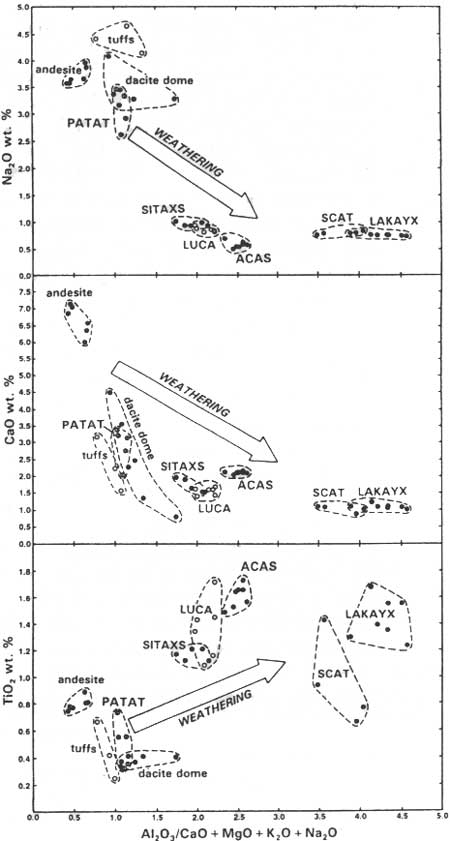
|
| Figure 2.25. Weathering trends from paleosols in "Red Hill." Parent material compositions of igneous rocks and tuffs from the Clarno area are also plotted. Scat and Lakayx pedotypes are from the lower, very strongly weathered part of Red Hill. Sitaxs and Luca pedotypes are from the upper, strongly weathered part of "Red Hill." |
Correlations of the stratigraphic subdivisions, and thus the stratigraphically controlled pedofacies, are based on Ar/Ar dates, estimates of the time of soil formation of paleosols, and stratigraphic thickness (Fig. 2.24). The duration of stratigraphic units is estimated by graphing stratigraphic thickness with time using these age determinations (Fig. 2.26). The timing of stratigraphic boundaries are estimated by linear extrapolation from two or more age determinations in the same unit. These linear extrapolations also approximate sedimentation rates since they represent thickness over time. The utility of graphic correlations such as Figure 2.26 depends on the stratigraphic completeness, the quantity and quality of the age determinations, and uniformity of sedimentation rates within units.
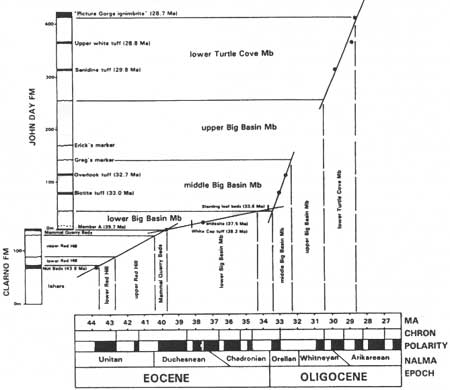
|
| Figure 2.26. Graphic correlation of the upper Clarno Formation units from the Clarno area and lower John Day Formation from the Painted Hills area. (click on image for an enlargement in a new window) |
In the conglomeratic deposits (conglomerates of the Palisades and conglomerates of Hancock Canyon), only weakly developed paleosols are present between some debris flow deposits. Sedimentation rates were high and time intervals between episodes of eruption and sedimentation where short, consequently, the paleosols are Entisol and Inceptisol-like paleosols. The Inceptisols-like paleosols, referred to as Patat and Sayayk pedotypes, represent 10's to 100 yrs of soil formation and their geochemical compositions are not much different from the andesitic to dacitic parent alluvium (Fig. 2.25).
In the lower part of "Red Hill," strongly developed, Ultisol-like paleosols of the Lakayx pedotype are present and represent a dramatic change in depositional setting from an active volcaniclastic apron of the conglomerates of Hancock Canyon to a quite floodplain. This change represents the cessation for a long period of time of proximal volcanic activity in at least this part of the Clarno Formation. Each Lakayx type paleosol represent approximately 50,000 years of soil formation in a humid paratropical climate. These paleosols and their associated poorly drained Scat pedotypes are the most weathered paleosols in the upper Clarno and lower John Day formations in the Clarno Unit area (Fig. 2.25).
In the upper part of "Red Hill," strongly developed Alfisol-like paleosols of the Luca pedotype dominate the section. Each Luca paleosol represents 20,000-50,000 years of soil formation in a humid paratropical climate. The change from Ultisol-like Lakayx to Alfisol-like Luca paleosols is interpreted as a result of climatic cooling and drying during the late Eocene. This break between the lower and upper "Red Hill" claystones may correlate to a period of oceanic cooling centered around paleomagnetic time interval chron R19 (reversed) which is thought to be caused by a major plate tectonic reorganization, best expressed by the bend in the Hawaiian-Emperor seamount chain but also recorded in new spreading in the Indian Ocean (Williams, 1986). The age of chron R19 has recently been adjusted to approximately 42 Ma by Cande and Kent (1992) which fits well with our 42.5 Ma estimated age of the boundary between the lower and upper "Red Hill" claystones (Fig. 2.26). Changing patterns of oceanic circulation and volcanism are the hypothesized causes for this climatic change (McGowan, 1989). The R19 plate tectonic reorganization may have caused the change from Clarno arc subduction to Cascade arc subduction. By this reasoning, "Red Hill" marks the end of voluminous Clarno volcanism. The change in paleosol type from lower to upper "Red Hill" marks the climatic change set in motion by the plate tectonic reorganization. The hiatus in volcanism recorded in the "Red Hill" section from 44 Ma to about 40 Ma, when John Day or Cascade volcanism began, is correlated to Gresens (1981) Telluride erosion surface and in central Oregon was a period of sporadic volcanism transitional from the Clarno to the Cascade arc.
Following this volcanic hiatus of approximately 2-4 million years, renewed volcanism, represented by the andesite of Horse Mountain, rejuvenated the alluvial system with fresh andesitic material and caused the deposition of the "Mammal Quarry" beds. More rapid alluvial aggradation and fresh andesitic material changed the soil type from red and clayey "Red Hill" type paleosols to the brown Inceptisol-like paleosols in the "Mammal Quarry" siltstones. These paleosols are too weakly developed to interpret much in the way of paleoclimate, except that it was humid and relatively warm.
With the onset of John Day volcanism, the dominent alluvial material changed from andesitic detritus to fine-grained rhyodacitic ash. In the late Eocene, lower Big Basin Member in the Clarno Unit area, strongly developed Alfisol-like paleosols of the Luca pedotype are the most weathered of the paleosols in this thick and varied section (Fig. 2.25). The geochemical composition of these John Day Luca paleosols are much the same as Clarno Luca paleosols and indicate little if any climatic change from late Clarno time to early John Day time. The higher amount of bases in the John Day paleosols is due to rhyodacitic parent material and pyroclastic rejuvenation. Not until approximately 34 my at the Eocene-Oligocene boundary did the climate change dramatically. In the Clarno area this boundary is marked by the change from the lower Big Basin Member to the middle Big Basin Member, or from Luca pedofacies to Ticam pedofacies. The change from subtropical to temperate conditions across this boundary is contrasted dramatically by comparing the Eocene "Nut Beds" flora and "Red Hill" Lakayx paleosols with the Oligocene Bridge Creek flora ("Slanting Leaf Beds") and middle Big Basin Member Ticam paleosols.
| <<< Previous | <<< Contents>>> | Next >>> |
joda/bestland-retallack1/chap2.htm
Last Updated: 21-Aug-2007
